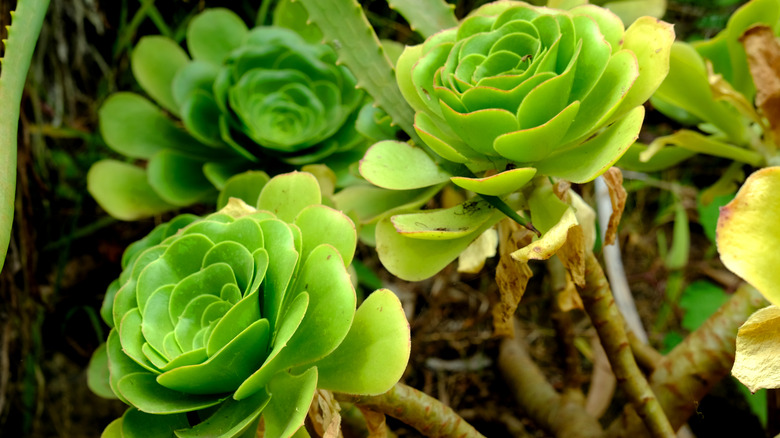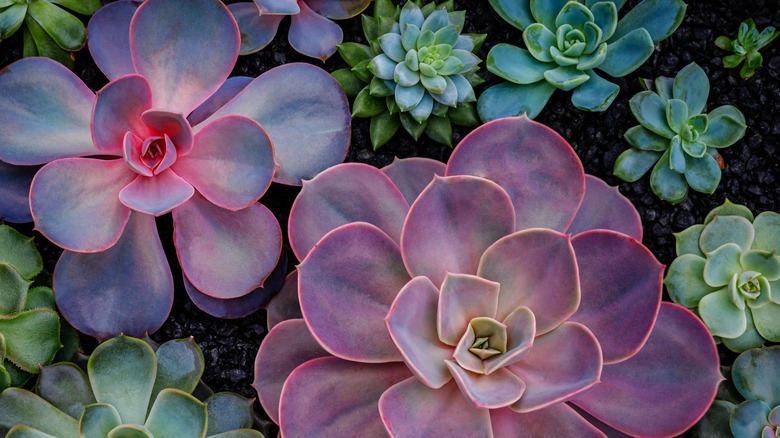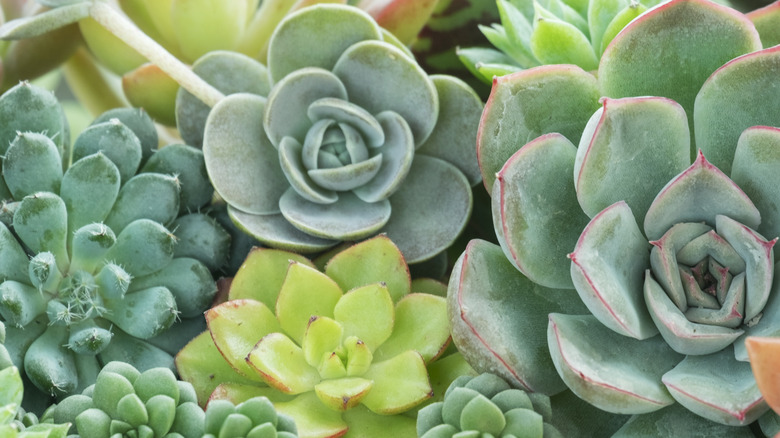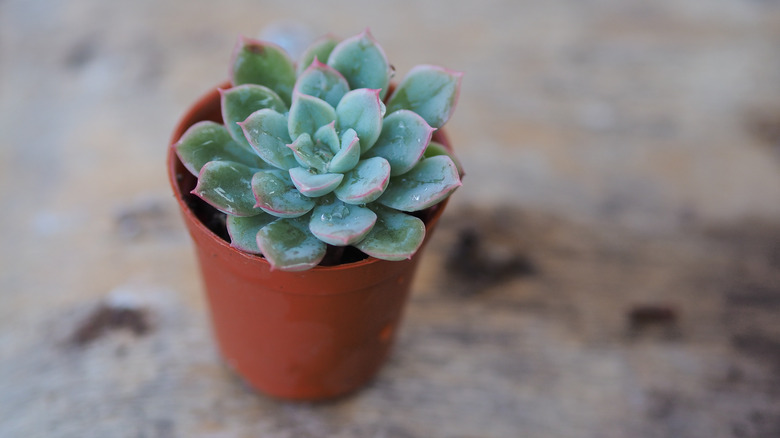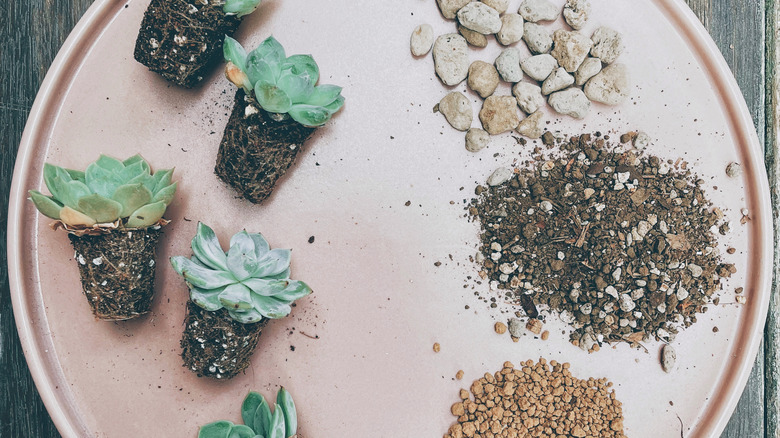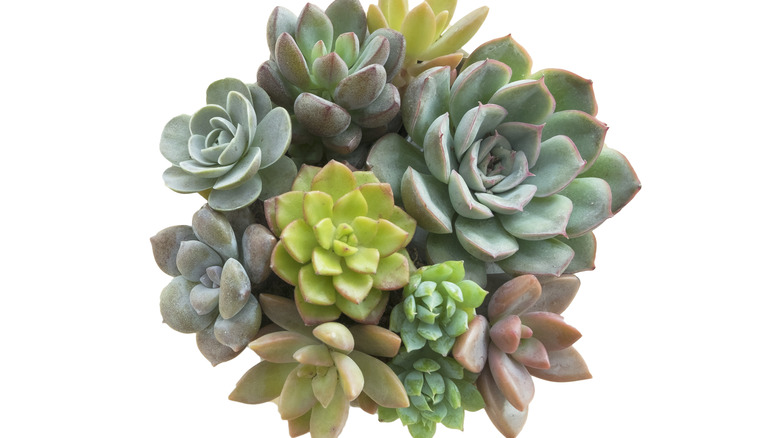How To Care For A Rose Succulent
We may receive a commission on purchases made from links.
The fairytale-esque rose succulent (scientific name: Aeonium dodrantale) is a newly trending plant that looks charmingly like a rose. House Beautiful ranks them even better than actual roses, thanks to the fact that they do not wither, are very little trouble to grow and give the gardener a pretty "bloom" all year long. However, Shakespeare's now-famous adage that a rose by any other name would smell just as sweet does not apply to this plant. According to Ask Gardening, while there are succulents that emit a pretty fragrance, the rose succulent is not one of them.
Failure of fragrance aside, this plant is adorable. A rose succulent grows only a few inches tall and has thick leaves that curve around much like a rose petal, though heartier, says Little Prince. Originally classified as Greenovia dodrentalis (they incorporated in 2003 to Aeonium dodrantale, according to Martha Stewart), the rose succulent hails from the Canary Islands, just off the coast of Spain. They like bright spaces and soil that drains well, but not too well since rose succulents need a little more moisture than most succulents, says Living Succulents. Keep reading for a guide on how to grow your own bouquet of these delightful plants.
How To Use Rose Succulents In A Garden
The word succulent comes from the Latin word for juice, says Plant Care Today, which is to say that they store water in their leaves or stem, so their roots do not need a lot of moisture. Because of this, you may consider planting them in a large pot with other succulents with similar soil and watering needs.
Rose succulents are pretty on their own, in a display with other succulents, or in a garden with other plants. Keep in mind that rose succulents are little and need a good bit of light, so the plant stagger of your garden needs to consider spaces that the rose succulent can compliment without getting swallowed up under the shadow of a huge nearby plant.
Rose succulents make nice houseplants even if you live in a small space, apartment or dorm. They look great on a windowsill since they can thrive even in pots as tiny as a few inches, says Little Prince.
How To Grow Rose Succulents
Rose succulents are not fussy, but growing your bouquet does take commitment. According to My Modern Met, it can take several years from seed before the plant looks like a legitimate rose bloom, so you may want to begin with a starter succulent that has already grown into a recognizable rose. These can be purchased at specialty nurseries and gardening stores or online. Once your rose succulent is mature, it will sprout its own sub-sprouts (pups) that you can cut and replant for more rosettes to sprout again from that bloom, says Living Succulents.
To plant rose succulents, start the process in the spring and begin with a container that has drainage holes, says Instagram plant guru @highway92succulents. She likes to use a cactus mix that you can buy ready-made or make your own at home. A home concoction calls for 2/3 good potting soil (like Super Soil or Miracle Grow) and modify that with 1/3 perlite or volcanic pumice. She tells her gardening followers to mix that up like cake batter before planting your rose succulent. Rose succulents can also be planted outside directly into the ground, says Kellogg Garden Products, but the soil needs to be succulent specific, including well-draining, rocky soil that is nutrient-rich.
How To Care For Rose Succulents
Although rose succulents originate from arid temperature zones, these little plants can stand a bit of adverse weather. For instance, Sublime Succulents says they can handle chilly temps so long as you get them out of the cold before any sign of first freeze or snow. With that in mind, if you are in snowy climates, your rose succulents need to be potted and brought in for the winter months. When deciding to bring your rose succulents back outside after a long winter, Succulents and Sunshine encourages you to wait for a consistent nighttime temperature that no longer threatens any hint of frost. As you re-integrate your rose succulents into your outside garden in the summer months, keep an eye that it gets enough (indirect, less intense) light, which will uphold that tightly compressed rosette look that most gardeners love so much, says Garden Beast.
Whether kept inside or outdoors, rose succulents require succulent-friendly soil but have a few peculiarities that are unique from other succulents. They grow in winter and are summer dormant, so winter is for a little more water and, according to Living Succulents, is the time to fertilize if needed. Water your rose succulents according to soil moisture, which could mean once every week or maybe every two. When the soil becomes completely dry, it is time to thoroughly saturate your rose succulent, says Sublime Succulents. Be sure to empty the drainage plate from excess water to avoid root rot.
How To Repot A Rose Succulent
World Of Succulents encourages gardeners to repot your rose succulent every two to three years. Dave's Garden suggests that this is best handled at the beginning of the growing season, which is the winter months. According to Master Class, you will know your rose succulents have outgrown their flowerpot when roots begin to show up on top of the soil. Also, if you see roots poking through the holes under your drainage pot, it is time for a bigger pot and fresh soil. Additionally, keep an eye out for soggy soil or mold on the surface of your rose succulent's soil. This is a signal that new soil is needed and repotting is necessary.
Rose succulents have short, shallow roots that you can gently dig up with a small trowel or even a spoon without cutting or damaging them. To get started, fill a larger pot with soil mix like the one described by @highway92succulents, which is a blend of 2/3 potting soil, 1/3 perlite or volcanic pumice. Hold off on watering for several days, says Succulent Plant Care.
Plant Specific Information To A Rose Succulent
Unlike other succulents, rose succulents are not propagated by using leaves but rather self-propagate by growing little baby buds that can be cut and replanted for more blooms. The process is simple, says The Spruce, and should be handled in spring. If you are propagating your rose succulent rosette pups or offshoot, simply snip it from the mother plant with sharp shears without damaging your original plant. Do not plant immediately. Rather, set your rosette on its side and keep it warm and dry for a few days while it forms a callous over the cut, which helps avert future root rot.
Once the callous has formed, says The Spruce, bury the stem of the rosette, making sure to stand the rosette upright in the soil. Water sparingly once a week until strong. Follow these guidelines for your own bouquet of charming rosebud lookalikes that will maintain their appeal all year long.
